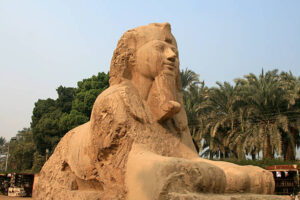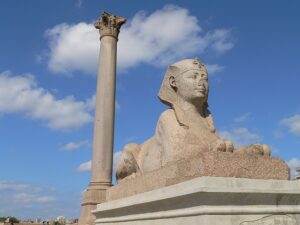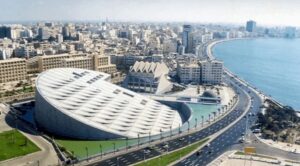5 days / 4 nights: 3 nights in Cairo + 1 nights in Alexandria

After the rest of the day at the hotel, we will head to one of the Seven Wonders of the Ancient World: the Pyramids of Giza.
The complex has three main pyramids of the pharaohs: Cheops, Khafre and Mycerinus.
Visit the Great Sphinx of Giza, built during the reign of Pharaoh Khafre (2620 BC).
Built from natural yellow calico stone, this unmistakable statue is 20 meters high and 57 meters wide and combines the head of a pharaoh with the body of a lion.

After a lunch stop at a local restaurant, transfer to Memphis, which was the first capital of Egypt and the center of government and culture for more than 3,000 years founded by King Menes.
You can also see the statue of King Ramses II.

Saqqara is an Egyptian village in Badrashin markaz (county) in the governorate of Giza, which contains ancient cemeteries of Egyptian royalty and serves as the necropolis of the ancient Egyptian capital, Memphis.
Saqqara It contains numerous pyramids, including the Pyramid of Djoser.
sometimes called Stepped Tomb, and several mastaba tombs.
Situated about 30 km (19 mi) south of present-day Cairo, Saqqara covers an area of around 7 by 1.5 km (4.3 by 0.9 mi).
Saqqara contains the oldest known complete stone building
complex.
You can also see the statue of King Ramses II.
The Qaitbay Citadel is a 15th-century defensive fortress located on the coast of the Mediterranean Sea, in Alexandria, Egypt.
It was built between 1477 and 1479 AD. C. (882–884 AH) by Sultan Al-Ashraf Sayf al-Din Qa’it Bay. The Citadel is located on the eastern side of the northern tip of Pharos Island at the mouth of the Harbor.
Built from natural yellow calico stone, this unmistakable statue is 20 meters high and 57 meters wide and combines the head of a pharaoh with the body of a lion.
of history, the Pyramid of Djoser, built during the Third Dynasty.
Sixteen other Egyptian kings built pyramids at Saqqara, which are now in various states of preservation.

The Qaitbay Citadel is a 15th-century defensive fortress located on the coast of the Mediterranean Sea, in Alexandria, Egypt.
It was built between 1477 and 1479 AD. C. (882–884 AH) by Sultan Al-Ashraf Sayf al-Din Qa’it Bay.
The Citadel is located on the eastern side of the northern tip of Pharos Island at the mouth of the Harbor.oriental.
Many structural modifications were made to the lighthouse after the Arab conquest of Egypt, but the lighthouse continued to operate for many centuries.
The restoration began in the period of Ahmed Ibn Tulun (around 880 AD).

Pompey’s Pillar or ship’s mast built in honor of Diocletian in 292 AD is located in Alexandria, in the area known as Kom el-Dekka, and dominates the area.
At the base of the pillar we find an inscription: “Postumas, a governor of Alexandria, erected this pillar in honor of the just emperor Diocletian.”

It is considered one of the Seven Wonders of the Middle Ages.
The Necropolis consists of a series of Alexandrian tombs, statues and archaeological objects of the pharaonic funerary cult with Hellenistic and early imperial Roman influences.
Due to the era, many of the features of the Kom El Shoqafa catacombs fuse Roman, Greek and Egyptian cultural points; Some statues are Egyptian in style, but sport Roman clothing and hairstyles, while other features share a similar style.

The Great Library of Alexandria in Alexandria, Egypt, was one of the largest and most important libraries in the ancient world.
The library was part of a larger research institution called Mouseion, dedicated to the Muses, the nine
goddesses of the arts.
The idea of a universal library in Alexandria may have been proposed by Demetrius of Phalerus, an exiled Athenian statesman living in Alexandria, to Ptolemy I Soter, who may have laid out plans for the
library, but the library itself was probably not built until the reign.
of his son Ptolemy II Philadelphus.

At night we will walk along the ledge to see the wonderful landscape and eat corn and potatoes on the ledge.
The same day we will return to Cairo and stay at the hotel.

It is located in the city of Fustat, Cairo, on an area of 33.5 acres and is expected to contain 50,000
artifacts from various eras of ancient Egypt to contemporary history, telling the stages of development of Egyptian civilization. in addition to showing the achievements of the Egyptian man until today.
Various areas of life since the dawn of history.
It also contains models, photographs, manuscripts, oil paintings, artistic artifacts and antiquities from the Stone Age, Pharaonic, Greek, Roman, Coptic, Arabic, Sudanese civilization and the modern era.
The museum site overlooks a natural lake, Lake Ain Al-Sira.
It includes a group of warehouses for the conservation of antiques equipped with the latest technologies.
The National Museum of Egyptian Civilization is considered the first museum of its kind in Egypt and the Arab world.
It is considered an integrated global cultural complex that provides its visitors with the opportunity. Sail on a journey through history to learn about successive Egyptian civilizations.

It is one of the palaces of the royal era in Egypt with a special architectural character.
The construction of the palace began in 1901 and is located on Manil Al-Rawda Island in Cairo on an area of 61,711 square meters, of which 5,000 square meters represents the building area.
The palace is considered a unique architectural masterpiece as it includes various styles of Islamic art, ranging from Fatimid, Mamluk, Ottoman, Andalusian, Persian and Levantine.
The palace includes three palaces: the residence palace, the reception palace and the throne palace.
In addition to the mosque, the private museum, the hunting museum and the clock tower, it has a wall in the style of medieval fortress walls, while its interior is surrounded by gardens that include a rare collection of trees and plants.
It is currently used as a museum.
The palace was owned by Prince Muhammad Ali, second son of Khedive Tawfiq and brother of Khedive
Abbas Hilmi II. He served as Crown Prince on three occasions and was one of the three guardians of the
throne during the period between the death of King Fouad I and the assumption of his constitutional
powers by his cousin, King Farouk, when he came of age. Prince Muhammad Ali chose the palace land
himself, initially built the palace residence and then completed the rest of the palaces.
Various areas of life since the dawn of history.
It includes a group of warehouses for the conservation of
antiques equipped with the latest technologies. The National Museum of Egyptian Civilization is
considered the first museum of its kind in Egypt and the Arab world. It is considered an integrated
global cultural complex that provides its visitors with the opportunity. Sail on a journey through history to
learn about successive Egyptian civilizations.
The prince developed the engineering and decoration designs and supervised the construction, while
the implementation was carried out by master Muhammad Afifi.
The prince recommended that the palace be transformed after his death into a museum.

The Mosque of Ibn Tulun is located in Cairo, Egypt.
It is one of the oldest mosques in Egypt, as well as in all of Africa, surviving in its complete original form, and is the largest mosque in Cairo in terms of area.
It is built around an open square patio that allows natural light to pass through.
The Ibn Tulun Mosque features ancient Egyptian architectural styles, and its decorations are created with carved stucco and wood.
This mosque is a popular tourist attraction.
The mosque was commissioned by the Tulun dynasty ruler Ahmad ibn Tulun, Abbasid governor of Egypt between 868 and 884, whose rule was characterized by de facto independence.
It was designed by the prominent Egyptian architect Saiid Ibn Kateb Al-Farghany.

The Sultan Hasan Mosque-Madrasa is a monumental mosque and madrasa located in Salah al-Din Square in the historic district of Cairo, Egypt.
It was built between 1356 and 1363 during the Bahri Mamluk period, commissioned by Sultan an-Nasir Hasan.
The mosque was considered notable for its enormous size and innovative architectural components,
and is still considered one of Cairo’s most impressive historical monuments today.

Breakfast..
Visit to the interesting Museum of Archaeological and Egyptian Art, where inside you will find a multitude of treasures from the pharaonic era and Tut’s Ankh-Amun collection.

The tour continues to the Citadel of Salah El Din, built to protect Cairo and Fustat from the crusaders and unite them into a single front.
Inside the citadel.
You can visit the alabaster mosque of Mohamed Ali.

Khan el-Khalili is a famous bazaar and souk (or souk) in the historic center of Cairo, Egypt. Established as a center of trade in the Mamluk era and named for one of its several historic caravanserais, the bazaar district has since become one of the Cairo’s top attractions for tourists and Egyptians alike.
It is also home to many Egyptian artisans and workshops involved in the production of traditional crafts and souvenirs.
The name Khan el-Khalili historically referred to a single building in the area; today it refers to the entire commercial district.
Do not hesitage to give us a call. We are an expert team and we are happy to talk to you.
+201070700426
Info@asteriscoegypt.com

